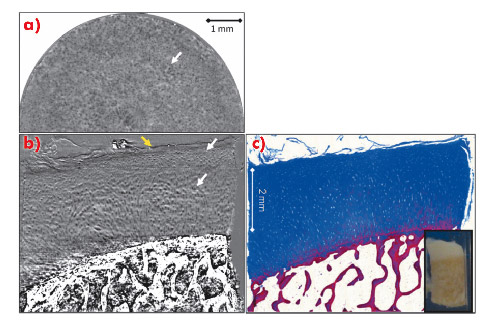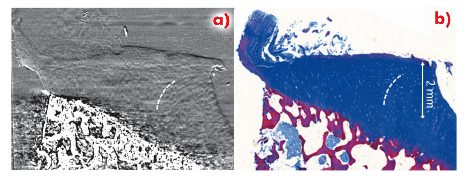- Home
- Users & Science
- Scientific Documentation
- ESRF Highlights
- ESRF Highlights 2010
- X-ray imaging
- Characterisation of human cartilage by phase-contrast imaging
Characterisation of human cartilage by phase-contrast imaging
Quasi-coherent X-rays have been proven capable of visualising the architecture of articular cartilage, which is invisible in conventional clinical radiographs. A novel X-ray imaging approach, phase contrast imaging (PCI), has been applied to study the fine structure of human cartilage in normal and pathologic conditions. The experiments were performed at ID17, the Biomedical beamline, where a particular PCI method, analyser-based imaging (ABI), was utilised [1]. This method exploits the properties of X-ray diffraction with a high quality crystal to generate images where contrast is due to a combination of X-ray absorption, refraction and ultra-small angle scattering. As a result, image contrast can be improved over conventional radiography.
 |
|
Fig. 127: ABI-CT of a normal cartilage sample at an X-ray energy of 26 keV with a detector pixel size of 82 µm2. a) Portion of an axial ABI-CT acquired at the level of the radial zone of the cartilage. b) Coronal plane extracted from the reconstructed ABI-CT volume. c) Histologic section (Azan staining) and photo of the original osteochondral cylinder (inset). |
Phase contrast analyser-based tomograms (ABI-CT) showed excellent depiction of the complete cartilage volume and of its 3D architecture in all samples imaged in this study. In Figures 127 and 128, reconstructed ABI-CT slices of a normal and an osteoarthritic sample are provided. The edges and interfaces between cartilage and calcified cartilage/subchondral bone and between the formalin and the cartilage surface (as indicated by the yellow arrow) are clearly discernible. These are attributable to refraction of the beam occurring at the edges between tissues with different refraction indexes. In the ABI images, low intensity oval shaped structures with an extent from 10–40 µm are detectable within the cartilage matrix. Comparison with the corresponding histology sections (Figures 127c, 128b) identifies these structures as chondrocytes and/or chondrons (the synthetically active elements in cartilage). In all ABI data, the tide mark (i.e. the interface between calcified and uncalcified cartilage), the subchondral bone plate (calcified cartilage + solid subchondral bone proper) and trabecular detail from within the spongiform bone can be appreciated. In particular, Figure 127a displays the above-mentioned dark oval dots (arrow), chondrocytes, against the brighter background of the cartilage matrix in an axial slice approximately at 75% depth from the surface (at the level of the radial zone). We can appreciate that chondrocytes are aligned perpendicular to the tide mark/surface, thus their cross sections in axial slices appear as circles (Figure 127a). Coronal reformats in both ABI (Figure 127b) and histology (Figure 127c) impressively demonstrate the typical pattern of chondrocyte alignment and distribution across the cartilage. The central portions of Figure 127b display Benninghoff’s ‘arch’ or ‘arcade’ like alignment of the chondrocytes/chondrons (i.e. clusters of chondrocytes): they initially rise vertically upwards from the tide mark but soon diverge laterally when approaching the cartilage surface following a curved trajectory. Figure 128 shows an osteoarthritic cartilage-on-bone sample. Areas of still intact, smooth appearing, cartilage surface (right aspect and mid portion of sample) alternate with subtle (right half of sample) and distinct (left half) surface erosions/defects (Figures 128a,b). A comparison based on histopathological parameters performed by two independent, blinded observers on the ABI-CT images clearly determined differences between the two groups of samples (normal and pathologic). A distinct zonal pattern in the cartilage matrix could consistently be visualised. The osteoarthritic samples showed significantly lower chondrocyte distribution homogeneity, less chondrocyte alignment, lower height of tangential, transitional, and radial zones and a higher prevalence of superficial cartilage damage.
 |
|
Fig. 128: a) Coronal plane from the ABI-CT volume of osteoarthritic cartilage. b) Corresponding (to the extent that is possible practically) section from histology. ABI-images acquired at an X-ray energy of 26 keV with a detector pixel size of 82 µm2. |
The results of this proof-of-concept study indicate that the phase contrast ABI-CT technique is capable of providing soft-tissue contrast at a histopathologic level, useful to differentiate osteoarthritic and healthy cartilage samples. We were able to show that fine structural details of the cartilage matrix as well as its degeneration in early and advanced stages of osteoarthritis can be visualised by ABI-CT in relatively large samples.
Principal publication and authors
P. Coan (a, b), F. Bamberg (a), P.C. Diemoz (b), A. Bravin (b), K. Timpert (a), E. Mützel (c), J. Raya (a), S. Adam-Neumair (d), M.F. Reiser (a) and C. Glaser (a), Investigative Radiology 45, 437-444 (2010).
(a) Ludwig-Maximilians University, Faculty of Medicine and Institute of Clinical Radiology, Munich (Germany)
(b) ESRF
(c) Ludwig-Maximilians University, Institute of Forensic Medicine, Munich (Germany)
(d) Ludwig-Maximilians University, Institute of Anatomy, Munich (Germany)
References
[1] A. Bravin, Journal of Physics D: Applied Physics vol. 36 (2003).
[2] P. Coan, F. Gruener, C. Glaser, T. Schneider, A. Bravin, M. Reiser and D. Habs, Nuclear Instruments and Methods in Physics Research A vol. 608 (2009).



